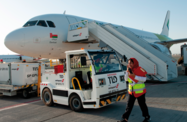Further progress towards the construction of a national rail network, along with long-awaited expansions in the port system, are highlighting Oman’s potential to become a lynchpin for commercial transport in the GCC. A special body will be set up within the Ministry of Transport and Communications to facilitate the installation of a new rail network in the Sultanate, Ahmed bin Mohammed Al Futaisi, the transport and communications minister, told local media on January 6th.
In a statement to the Oman News Agency, Al Futaisi said the ministry had begun accepting financial and technical offers from pre-approved companies for the tender of consultancy and design services. These companies would advise the government on the construction of the planned 1061-km rail network, which will extend from the north-eastern governorate of Al Buraimi to the south-eastern governorate of Al Duqm, running through Sohar and the Muscat Governorate.
One of the main objectives of the rail line is to improve commercial transport. There will also be several sub-branches for increased connectivity to ports and power plants, extending to the Sohar Industrial Port and the Ibra Governorate, located approximately 150 km south of Muscat.
Set to be completed in 2017, the project is intended to link Oman to the planned pan-GCC network. The first phase of the project will be the Batina railway, a 200-km stretch of track linking Sohar to Barka, west of Muscat. The line will then be extended to connect to the UAE at Khatmat Malaha, in Fujairah.
There will be another connection between Sohar and Buraimi, which will then link to the emirate of Al Ain. An additional line could connect Oman to Yemen, running from Duqm through the Dhofar Governorate, though no official timeline for this connection has been established, local media has reported.
According to Al Futaisi, the network has been designed to manage freight trains running at between 80 km per hour and 120 km per hour, and passenger trains travelling up to 200 km per hour, in line with the GCC railway standards.
The shared-cost trans-GCC network is expected to cost around $25bn and planned to comprise two lines: one 1970-km line that will connect all GCC countries and Qatar by way of a bridge, and a second 1984-km line that will stretch from Kuwait to Oman, passing through Saudi Arabia and the UAE. GCC member states will spend approximately $79bn on new rail projects between 2011 and 2020, according to figures released in early January by local consulting firm Ventures Middle East.
These new rail connections will be particularly useful in providing commercial connections to and from Oman’s ports, notably the thriving Port of Sohar. A joint venture between the Omani government and the Port of Rotterdam in the Netherlands, the Port of Sohar is gaining significant attention, having received investments thus far of more than $14bn.
The government announced last July its intention to begin moving all container traffic from Port Sultan Qaboos (PSQ) in Muscat to the Port of Sohar by the end of 2012, adding that many of PSQ’s industrial facilities would also be transferred to Sohar.
A temporary bulk terminal facility, with the ability to accommodate vessels of up to 16-metre draft, began operations in Sohar in mid-December, presenting a variety of new opportunities for local companies, particularly those hoping to export quarried goods. According to Jan Meijer, the group CEO of the Sohar Industrial Port Company and the Sohar International Development Company, the bulk terminal could be a source of jobs for locals, as more companies will be able to mine and export minerals from the Batinah region.
Operations are currently under way to finalise the construction of the permanent bulk terminal, the designs for which include a 3.5-km-long conveyor belt system that will connect the storage yard with the terminal, as well as a capacity of 10m tonnes per annum.
Sohar’s growth and potential has not gone unnoticed. More international firms are beginning to set up operations at the port. The global container shipping company APL, for example, launched two additional services – Pakistan Middle East Express and Subcontinents Red East Express – in mid-January. The Pakistan line, which will connect Sohar with the UAE and Karachi, Pakistan, will operate one vessel with a capacity of 3398 twenty-foot equivalent units (TEUs). The Subcontinents Red East Express service operates four 3502-TEU-capacity vessels and stops in Sohar and the Indian ports of Mundra and Nhava Sheva, as well as in Djibouti and Jeddah, Saudi Arabia.
In light of recently heightened global tensions with Iran, Oman is increasingly appreciated as a stable and dependable partner for commercial shipping purposes. With upcoming expansions of port services, and new rail lines that will connect port cities to the rest of Oman – and eventually to the entire GCC – it seems the Sultanate will soon be reaping the rewards of investments in its transport sector.

